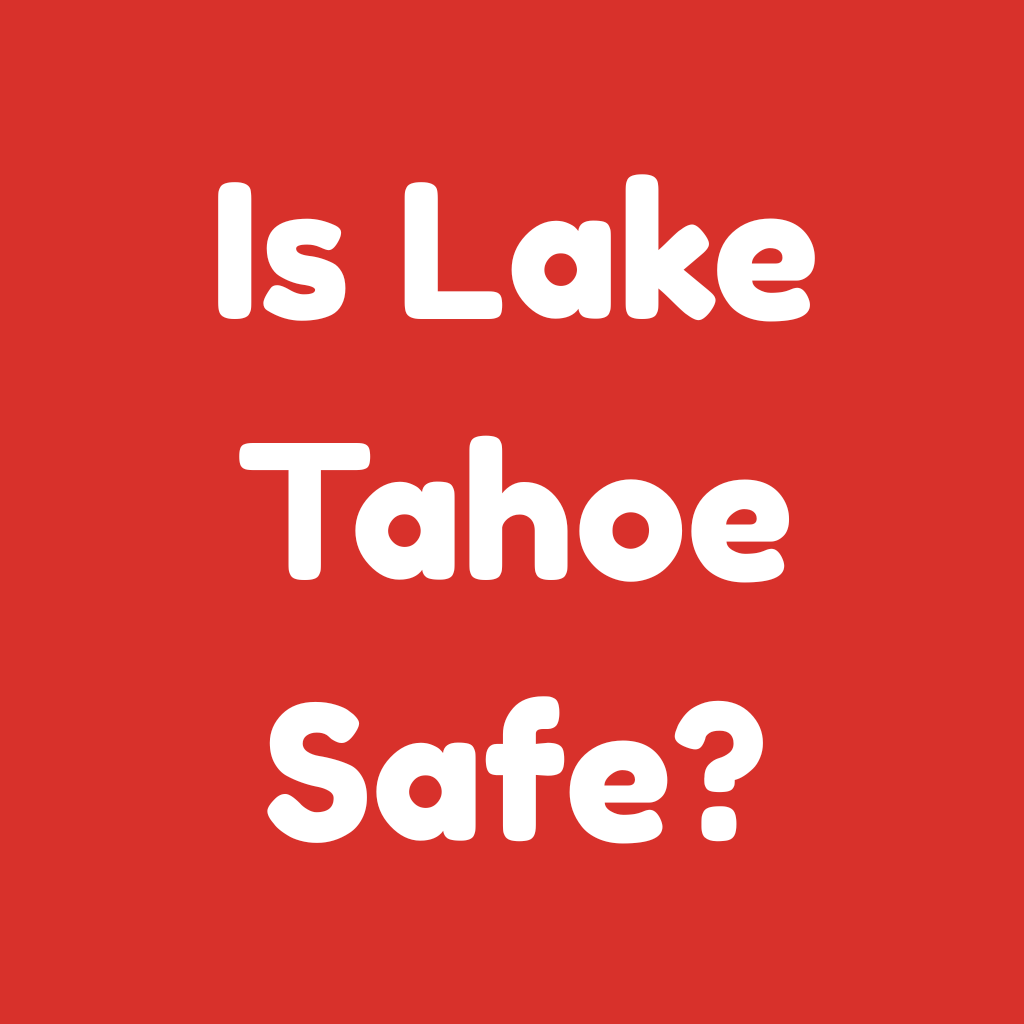Is Lake Tahoe Safe?
Nestled in the Sierra Nevada Mountains, Lake Tahoe is one of the most beautiful and popular destinations in the United States, attracting millions of visitors every year.
Whether you’re planning to hit the slopes in the winter, enjoy a boat ride on the lake in the summer, or simply bask in the natural beauty of the area, one question likely crosses your mind: Is Lake Tahoe safe?
In this post, I’ll dive deep into everything you need to know about safety in Lake Tahoe. From outdoor activities to general travel tips, I’ll provide you with practical insights, share personal experiences, and help you make informed decisions for a safe and enjoyable trip.
Why the Safety of Lake Tahoe Matters
We all want to enjoy our vacations without any unpleasant surprises. But when you’re visiting a place like Lake Tahoe, where outdoor adventures are the star of the show, there are some safety concerns that you may not immediately think about.
Is the lake safe for swimming? How about hiking or skiing? What about safety in the surrounding towns?
General Safety Concerns in Lake Tahoe
Before diving into specific activities, it’s important to know some general tips that can help you stay safe in the Lake Tahoe area.
While Lake Tahoe is a very safe destination overall, like any popular tourist spot, it’s important to stay vigilant and prepared.
Here’s a table with common safety tips for all travelers:
| Concern | Safety Tip | Why It’s Important |
| Weather | Check the weather forecast daily and be prepared for sudden changes. | The mountain weather can change quickly and dramatically. |
| Altitude Sickness | Drink plenty of water and avoid overexertion, especially if you’re from a lower elevation. | The higher altitude can cause headaches, dizziness, and fatigue. |
| Wildlife | Keep a safe distance from animals, especially bears and mountain lions. | Lake Tahoe is home to many wild animals, and it’s important to respect their space. |
| Water Safety | Always wear a life jacket when boating or swimming. | The cold water temperatures can cause hypothermia, even in the summer. |
| Sun Exposure | Use sunscreen, wear hats, and stay hydrated. | The high altitude means you’re closer to the sun, increasing the risk of sunburn. |
Safety in Outdoor Activities
Lake Tahoe is renowned for its outdoor activities, from hiking and skiing to boating and biking. Each activity comes with its own set of safety considerations, so let’s explore how to enjoy these adventures safely.
Hiking and Trails Safety
Hiking is a popular activity at Lake Tahoe, with dozens of scenic trails. However, the terrain can be rugged, and some hikes can be quite strenuous, especially if you’re not used to the high altitude. Here’s what you need to know:
- Know your limits: Some of the trails can be challenging. Always pick a hike that matches your fitness level.
- Bring plenty of water: The dry, high-altitude climate can lead to dehydration quickly, so carry enough water for your entire hike.
- Prepare for emergencies: Know the trail’s length, difficulty, and expected conditions. Let someone know your route and expected return time.
Skiing and Snowboarding Safety
Lake Tahoe is home to several world-class ski resorts, such as Heavenly, Squaw Valley, and Northstar. Skiing and snowboarding can be incredibly fun, but also risky. Here’s how to stay safe on the slopes:
- Wear proper gear: Helmets, goggles, and layered clothing are essential. Snow conditions can change, and being properly equipped is key to staying safe.
- Follow resort rules: Always stick to marked trails and obey the ski patrol’s advice. Going off-trail can lead to accidents or getting lost.
- Take a lesson: If you’re a beginner, consider taking a lesson from a certified instructor to learn proper techniques and how to avoid common mistakes.
Boating and Swimming Safety
Whether you’re renting a boat, kayaking, or simply enjoying the beach, Lake Tahoe’s clear, cold waters provide a stunning backdrop for water activities. But with these activities comes the responsibility to stay safe:
- Life jackets are a must: Always wear a life jacket, regardless of your swimming abilities. The lake’s cold water temperatures can cause even strong swimmers to panic.
- Be aware of boating traffic: Lake Tahoe is a popular destination for boaters, so be sure to watch out for other boats to avoid accidents.
- Swim in designated areas: Avoid swimming in areas that are not marked for swimming, as some parts of the lake have strong currents.
Crime and Safety in Lake Tahoe’s Towns
The towns surrounding Lake Tahoe, such as South Lake Tahoe, Truckee, and Stateline, are generally safe, but like any popular tourist spot, there are areas where you should exercise caution. Let’s break it down:
- Property Crime: Petty theft and car break-ins can occasionally happen, especially in popular tourist spots or parking lots. Always lock your car and keep valuables out of sight.
- Drunken Behavior: Some of the bars around Lake Tahoe can get rowdy, particularly in the winter months when the slopes are in full swing. Be cautious, especially at night, and stick to well-lit areas.
- Personal Safety: Most violent crime in the area is rare, but it’s always best to be cautious when walking alone at night or in unfamiliar areas. Stick to well-populated areas and avoid walking alone after dark.
Here’s a quick checklist for safety in the towns surrounding Lake Tahoe:
| Safety Tip | Details | Why It’s Important |
| Lock your vehicle | Always lock your car and hide valuables inside. | Prevents theft, especially in tourist-heavy areas. |
| Stick to busy areas at night | Avoid isolated areas after dark. | Helps you stay visible and avoid risky situations. |
| Use well-lit parking lots | Opt for parking lots with adequate lighting. | Deters potential thieves from targeting your car. |
Common Mistakes to Avoid in Lake Tahoe
When visiting Lake Tahoe, it’s easy to get caught up in the excitement of the moment. However, there are some common mistakes that can compromise your safety or detract from your experience. Here are some to avoid:
- Underestimating the altitude: If you’re not used to high altitudes, take it easy the first day and stay hydrated. Avoid overexerting yourself on your first day.
- Not checking weather conditions: Especially in the mountains, weather can change rapidly. Always check forecasts and be prepared for sudden changes.
- Ignoring safety gear: Whether hiking, skiing, or boating, wearing the right gear is essential. Skipping on helmets or life jackets is a dangerous mistake.
- Overpacking your schedule: Trying to do too many activities in one day can lead to exhaustion and mistakes. Give yourself time to relax and enjoy the scenery.
Personal Insights and Conclusion
Lake Tahoe is undoubtedly one of the most beautiful and adventurous destinations in the U.S., and it’s certainly safe to visit as long as you stay aware and follow safety precautions.
Having visited several times, I can confidently say that if you plan ahead, know the risks, and take basic safety measures, you’ll have an unforgettable trip.
- Lake Tahoe is a generally safe destination, but outdoor activities come with inherent risks.
- Always prepare for altitude changes, changing weather, and the potential hazards of hiking, skiing, and boating.
- Stick to well-lit areas in the towns surrounding the lake, lock your vehicle, and be cautious of your surroundings.
- Don’t rush take time to enjoy the beauty of the area and give yourself space to relax and recharge.
If you’re ready for a safe and adventure-filled trip to Lake Tahoe, follow these tips, stay aware of your surroundings, and enjoy everything this stunning location has to offer!
FAQs
1. Can you swim in Lake Tahoe?
Yes! Swimming in Lake Tahoe is a popular activity, but it’s essential to be aware of the cold water temperatures. Wear a life jacket, and swim in designated areas for safety.
2. Is there a lot of crime in Lake Tahoe?
While Lake Tahoe is generally safe, petty theft can happen in busy areas or parking lots. Always lock your car and avoid leaving valuables in sight.
3. What should I pack for a trip to Lake Tahoe?
Pack for varying weather conditions, especially in the mountains. Essentials include layered clothing, sunscreen, a first-aid kit, and safety gear for outdoor activities.
4. How do I avoid altitude sickness?
Stay hydrated, avoid overexertion, and allow your body to acclimate to the higher elevation gradually.







